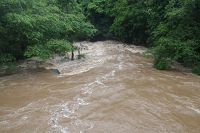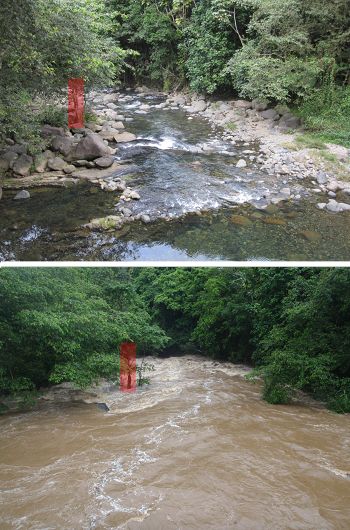Extreme Rainfall Doesn’t Always Mean Extreme Erosion, Penn Study Finds
Self-organization of river channels as a critical filter on climate signals
by Colin B. Phillips (University of Minnesota) and Douglas J. Jerolmack (University of Pennsylvania)
Abstract
Spatial and temporal variations in rainfall are hypothesized to influence landscape evolution through erosion and sediment transport by rivers. However, determining the relation between rainfall and river dynamics requires a greater understanding of the feedbacks between flooding and a river’s capacity to transport sediment. We analyzed channel geometry and stream-flow records from 186 coarse-grained rivers across the United States. We found that channels adjust their shape so that floods slightly exceed the critical shear velocity needed to transport bed sediment, independently of climatic, tectonic, and bedrock controls. The distribution of fluid shear velocity associated with floods is universal, indicating that self-organization of near-critical channels filters the climate signal evident in discharge. This effect blunts the impact of extreme rainfall events on landscape evolution.
Press Release from PennNews:
Extreme Rainfall Doesn’t Always Mean Extreme Erosion, Penn Study Finds
Photographs of the same section of the Mameyes River show normal and flood states. A tree is marked for reference.
Media Contact: Katherine Unger Baillie | kbaillie@upenn.edu | 215-898-9194
May 5, 2016
In the Puerto Rican rain forest, a strong storm can drop a meter of rain in a single day. All that water rushes into mountain rivers and causes a torrent as the water overflows the riverbanks and charges downstream.
It seems intuitive that the force of so much water would lead to massive erosion of a riverbed. But according to a new study by University of Pennsylvania researchers, that intuition is incorrect.
The work, published in the journal Science, shows that, though extreme precipitation events can greatly increase the amount of water traveling through a river, large storms only move about 50 percent more sediment than a typical rainfall. The overall contribution of these intense rainfalls to erosion, therefore, is smaller than might be expected.
With climate change expected to bring more intense precipitation in many regions of the globe, the findings indicate that, while these extreme rainfall events may at first lead to more flooding, river channels may rapidly increase their size to accommodate the flow.
Conitnue reading this press reslease at PennNews.
For more on this study, an article "Rivers Can Resist Floods from Climate Change" by Josh Fischman in Scientific American was published on May 5, 2016.
Photographs of the same section of the Mameyes River show normal and flood states. A tree is marked for reference.
News Source:
READ MORE from Penn News >>
News Category:
RESEARCH
Explore Further




